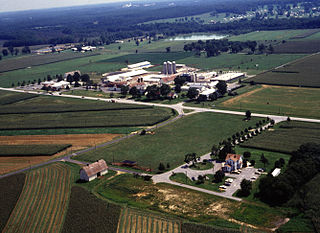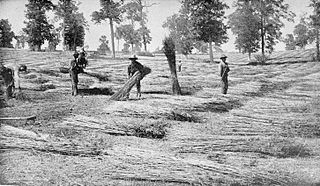
The Marihuana Tax Act of 1937, Pub. L.Tooltip Public Law 75–238, 50 Stat. 551, enacted August 2, 1937, was a United States Act that placed a tax on the sale of cannabis. The H.R. 6385 act was drafted by Harry Anslinger and introduced by Rep. Robert L. Doughton of North Carolina, on April 14, 1937. The Seventy-fifth United States Congress held hearings on April 27, 28, 29th, 30th, and May 4, 1937. Upon the congressional hearings confirmation, the H.R. 6385 act was redrafted as H.R. 6906 and introduced with House Report 792. The Act is referred to, using the modern spelling, as the 1937 Marijuana Tax Act. It was overturned in 1969 in Leary v. United States, and was repealed by Congress the next year.

The Agricultural Research Service (ARS) is the principal in-house research agency of the United States Department of Agriculture (USDA). ARS is one of four agencies in USDA's Research, Education and Economics mission area. ARS is charged with extending the nation's scientific knowledge and solving agricultural problems through its four national program areas: nutrition, food safety and quality; animal production and protection; natural resources and sustainable agricultural systems; and crop production and protection. ARS research focuses on solving problems affecting Americans every day. The ARS Headquarters is located in the Jamie L. Whitten Building on Independence Avenue in Washington, D.C., and the headquarters staff is located at the George Washington Carver Center (GWCC) in Beltsville, Maryland. For 2018, its budget was $1.2 billion.

Hemp oil is oil obtained by pressing hemp seeds. Cold pressed, unrefined hemp oil is dark to clear light green in color, with a nutty flavor. The darker the color, the grassier the flavour. It should not be confused with hash oil, a tetrahydrocannabinol-containing oil made from the Cannabis flower.

Hemp, or industrial hemp, is a botanical class of Cannabis sativa cultivars grown specifically for industrial and consumable use. It can be used to make a wide range of products. Along with bamboo, hemp is among the fastest growing plants on Earth. It was also one of the first plants to be spun into usable fiber 50,000 years ago. It can be refined into a variety of commercial items, including paper, rope, textiles, clothing, biodegradable plastics, paint, insulation, biofuel, food, and animal feed.
The United States National Agricultural Library (NAL) is one of the world's largest agricultural research libraries, and serves as a national library of the United States and as the library of the United States Department of Agriculture. Located in Beltsville, Maryland, it is one of five national libraries of the United States. It is also the coordinator for the Agriculture Network Information Center (AgNIC), a national network of state land-grant institutions and coordinator for the U.S. Department of Agriculture (USDA) field libraries.

Hemp for Victory is a black-and-white United States government film made during World War II and released in 1942, explaining the uses of hemp, encouraging farmers to grow as much as possible. During World War II, the Marihuana Tax Act of 1937 was lifted briefly to allow for hemp fiber production to create ropes for the U.S. Navy but after the war hemp reverted to its de facto illegal status.
The Hemp Industries Association (HIA) is a non-profit trade group representing hemp companies, researchers and supporters in the United States and Canada. The group petitions for fair and equal treatment of industrial hemp. Since 1994, the HIA has been dedicated to education, industry development, and the accelerated expansion of hemp world market supply and demand.

The Henry A. Wallace Beltsville Agricultural Research Center (BARC), also known as the National Agricultural Research Center, is a unit of the United States Department of Agriculture's Agricultural Research Service. It is located in unincorporated Prince George's County, Maryland, with sections within the Beltsville census-designated place. The BARC is named for Henry A. Wallace, former United States vice president and secretary of agriculture. BARC houses the Abraham Lincoln Building of the National Agricultural Library.
Lyster Hoxie Dewey (1865–1944) was an American botanist from Michigan.

Arlington Farms was a temporary housing complex for female civil servants and service members during World War II. Built in 1942–1943 by the United States Government's Federal Works Agency (FWA), Arlington Farms was located on the former site of the United States Department of Agriculture's Arlington Experimental Farm on the grounds of the historic 1,100-acre Custis-Lee family estate in Arlington County, Virginia, outside Washington, D.C.

Kentucky was the greatest producer of hemp in the United States during the 19th and 20th centuries, when it was the source of three fourths of U.S. hemp fiber. Production started to decline after World War I due to the rise of tobacco as the cash crop in Kentucky and the foreign competition of hemp fibers and finished products. In 1970, federal policies virtually banned the production of industrial hemp during the War on Drugs saying all Cannabis sativa is a Schedule I controlled substance. Federal law under the Agricultural Act of 2014 allowed research back into hemp. Kentucky began production again with 33 acres in 2014. As of the 2016 harvest season, only two U.S. states other than Kentucky had over 100 acres (40 ha) in hemp production: Colorado and Tennessee. The first 500-acre commercial crop was planted in Harrison County in 2017, and research permits were issued for over 12,000 acres (4,900 ha) that year. The 2016 documentary Harvesting Liberty concerns the 21st century Kentucky hemp industry.

Cannabis is illegal in Russia. Possession of up to 6 grams is an administrative offense, punishable by a fine or detention of 15 days. Possession of larger amounts is a criminal offense.
Hemp paper is paper varieties consisting exclusively or to a large extent from pulp obtained from fibers of industrial hemp. The products are mainly specialty papers such as cigarette paper, banknotes and technical filter papers. Compared to wood pulp, hemp pulp offers a four to five times longer fibre, a significantly lower lignin fraction as well as a higher tear resistance and tensile strength. Because the paper industry's processes have been optimized for wood as the feedstock, production costs currently are much higher than for paper from wood.
The Hemp Farming Act of 2018 was a proposed law to remove hemp from Schedule I controlled substances and making it an ordinary agricultural commodity. Its provisions were incorporated in the 2018 United States farm bill that became law on December 20, 2018.
Hemp in the U.S. state of Washington has emerged as an experimental crop in the 21st century.

The 2018 farm bill or Agriculture Improvement Act of 2018 is an enacted United States farm bill that reauthorized $867 billion for many expenditures approved in the prior farm bill. The bill was passed by the Senate and House on December 11 and 12, 2018, respectively. On December 20, 2018, it was signed into law by President Donald Trump.

Hemp in the United States was a legal crop in the 18th and 19th centuries. Production was effectively banned in the mid-20th century, but it returned as a legal crop in the 21st century. By 2019, the United States had become the world's third largest producer of hemp, behind China and Canada.
Tochigishiro is a cultivar of hemp grown in Tochigi Prefecture, Japan. It meets international standards of non-narcotic agricultural hemp at about 0.2% THC, reckoned "remarkably low" by Sensi Seeds. It was grown in the early 20th century at Arlington Experimental Farm near the United States capital. The modern variety was developed beginning in 1973 by Fukuoka University professor of pharmacy Itsuo Nishioka from seeds "found in southern Japan", and completed c. 1982 by the Tochigi prefectural government at Tochigi Agricultural Experiment Station in Tochigi-shi. According to a National Institute of Mental Health-affiliated researcher, the strain is missing the enzyme tetrahydrocannabinolic acid synthase that makes most Cannabis capable of producing THC. It is the most widely grown cultivar in Japan in the 21st century, being exempt from prohibition under the Cannabis Control Law, due to its low levels of psychoactive chemicals. Approximately 90% of the hemp grown in Japan is the Tochigishiro variety.










